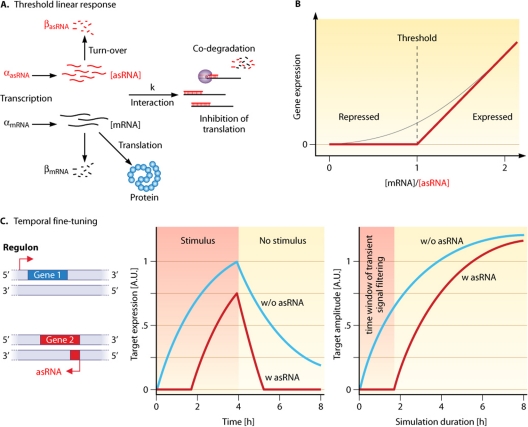Fig. 6.
Quantitative effects of asRNAs on the modulation of gene expression in the threshold linear response model. (A) In the threshold linear response, the mRNA and its asRNA regulator interact in a stoichiometric way with each other. The transcription rates (α) and the individual degradation rates (β) define the concentrations of mRNA ([mRNA]) and asRNA ([asRNA]) that are available for interaction with the rate (k) to be sequestered or codegraded (also see Fig. 2 for the special case of IsrR/isiA codegradation that follows this model) (50). (B) Graphical representation of the threshold linear response caused by the presence of an asRNA. The threshold is set by the ratio of mRNA/asRNA (52). The black line illustrates the theoretical behavior if the asRNA and target interact completely and instantly. In reality, there is no sharp transition point, and the actual response depends on the interaction rate between the regulator and target (illustrated by the gray line). (C) The expression of genes belonging to one and the same regulon is temporally shifted by the presence of an asRNA. Without an asRNA regulator, a gene is expressed directly upon the onset of a stimulus, and when the stimulus disappears, the mRNA level declines relatively slowly via its intrinsic turnover rate (blue line, middle). The asRNA facilitates a temporal delay of gene expression and a faster expression cutoff due to codegradation with its target (red line, middle). If a stimulus is only of a transient nature, e.g., because of short-term environmental changes or noise in upstream regulatory loops, it is filtered by the function of the asRNA (right). A.U., arbitrary units. (The two plots are adapted from reference 50 with permission of Elsevier.)

